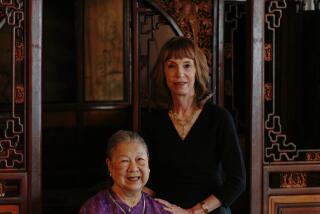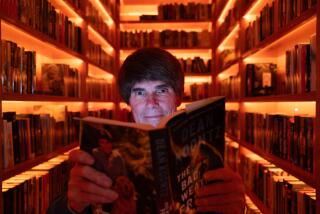Curator Rekindles Early Chapter of Doheny Archives
No longer can her blue eyes focus on the rare books she once helped track down and assemble into a world-renowned collection. No longer is she courted by dealers of rare books and manuscripts eager for her approval. Her mentor and former employer, Estelle Doheny, has been dead now for 30 years.
But from her one-bedroom apartment across the street from Ventura College, 87-year-old Lucille Miller remembers it all.
Sixty years ago, she answered an ad for a temporary typist and stayed on to become secretary and curator for Doheny, one of the biggest philanthropists and collectors of literature and art in California history.
The literary waltz lasted 30 years and twirled her into the arms of medieval monks and Romantic poets and authors of classics the world over, and even the five-century-old printer who started it all--Johann Gutenberg.
Those fleeting dalliances with fame and fortune took the place of a marriage and children for Miller, an articulate, self-taught woman who lived at home until her mother’s death in 1970.
Happily Unmarried
“I thought I was missing a good part of life by not marrying, but I was happy in my life, building up that collection,” Miller says.
“All the women I knew in the rare-book field never married. We were intellectual women with careers, and . . . we were very devoted to our work. When I was in my 30s, I never heard of the expression, ‘Having it all.’ ”
Although Miller claimed not to know a rare book from a pulp novel when Doheny hired her, she soon learned.
She helped track down first editions signed by their American authors. She catalogued their history and ownership. One illuminating fall day 38 years ago, Miller held her breath as Doheny undid a package and gazed, for the first time, upon her own copy of the Gutenberg Bible, one of 48 in existence.
Today that Bible belongs to a Japanese collector who paid a record $5.39 million for it last October. And the rest of Doheny’s prized collection will soon scatter to the four winds as a series of seven auctions, one of which concludes today at St. John’s Seminary in Camarillo, disperses it all.
Miller harbors no bitterness about the breakup of the collection that was at the center of her life.
Soon, nothing from the treasure trove Doheny donated to the seminary will remain there. And nobody but a few surviving family members will recall the glow that suffused Doheny’s face when she acquired a 1789 first edition of William Blake’s Songs of Innocence, a 1663 Algonquin Indian Bible, a 16th-Century Brussels garden tapestry or any of the rest of the extensive collection that took decades to assemble.
Except for Lucille Miller.
Miller is almost blind now. Ironically, the Doheny Eye Institute that Estelle Doheny founded in 1947 can’t halt her degenerative eye disease.
But the former curator reads nonetheless with the help of tapes. Today, she prefers tales of spinsters caught up in ill-fated romances to classic texts. Cassettes of Barbara Pym’s “Excellent Women” are stacked neatly on her divan.
Above it hangs a 1740 watercolor of a magnolia by German painter G.D. Ehret. It was a gift from Doheny, and Miller cherishes it with the fervor forged from devoting one’s best years to the service of another.
“She was absolutely the foundation stone of my life,” Miller says of Doheny. “Everything revolved around her.”
Lived With Mother
Although Miller lived with her mother in a cozy Glendale cottage, her sun rose and set in a more rarefied world at 8 Chester Place in Hancock Park.
This was the Doheny Mansion, where every weekday morning from 1931 to 1958, Miller drove up in her Model T and, later, Model A Ford, at 8:15.
Doheny, who rose at 5:30 a.m., would already be at work, having attended Mass in her private chapel and finished with breakfast.
At first, Miller’s task was merely to catalogue the rare books that Doheny, with her voracious collector’s appetite, was already beginning to acquire.
Until Doheny hired architect Wallace Neff to design the Spanish colonial-style library at St. John’s Seminary, the growing collection remained at 8 Chester Place.
Books filled the shelves lining oak-paneled walls, and Miller recalls that acquisitions were stacked high on a long table in the billiards room, below an imposing glass chandelier.
Often, dealers from New York and London shipped out books on consignment, hoping to pique Doheny’s interest.
The two ladies would bend their heads over the volumes, trying to assess rarity, significance and value.
“We sort of learned the book-collecting game together,” Miller says. “She always wanted to know what I thought. She would say if there was a choice, which one I would prefer.”
Miller recalls that Doheny was bitten by the collecting bug in the late 1920s, when she became a virtual recluse because of her husband’s illness. Oilman Edward Doheny was confined to a wheelchair at this time, and his wife, who rarely left his side or the house, cast about in vain for something to occupy her time.
One day, someone showed her a bibliography of great American literary works, and Doheny “thought it would be fun to collect them all,” Miller said.
Thus was a lifelong passion born.
Not Much of a Reader
Miller recalls that Doheny wasn’t much of a reader, but she quickly became a discriminating collector.
“She had a sort of instinct. She understood quality and went for the finest copies,” Miller says.
With her hair piled high on her head, Doheny sat at her throne--a massive, wood-carved desk that formed the centerpiece of her office. At the desk’s other end sat Miller, who penned entries into the loose-leaf ledgers in her spidery handwriting.
Long before conference calls and speaker boxes consumed American corporate culture, Miller and Doheny knew the importance of the telephone. Three telephone lines fed into Doheny’s office: one for Miller, one for Doheny’s business calls and a private line whose closely guarded number was known only by the philanthropist’s immediate family and friends. Scattered throughout the mansion were 34 other phones--at least one to a room, Miller recalls.
Miller remembers Doheny as a warm-hearted dynamo whose intense brown eyes were constantly ablaze with energy.
The book-collecting passion also soon inflamed Miller, who had dreamed of college but went to work at 17 to support her mother when her father died.
Although she held jobs on the periphery of university life, including stints as secretary to the head librarian at Columbia University and secretary to the president of the University of Arizona, it wasn’t until Miller worked for Doheny that she plunged headlong into the close-knit bookish world of the collector.
‘All Wrapped Up’
“You get all wrapped up . . . and it becomes an absorbing interest when you bid on a thing and you get it or you don’t,” Miller says. “That’s the fun of collecting.”
One of Doheny’s defeats came in the 1940s, when she bid unsuccessfully for a copy of the 15th-Century Gutenberg Bible, the first printed text.
The blow was assuaged in 1950, when the volume reappeared on the market, and Doheny purchased it from a private dealer in England.
Working with Miller, Doheny acquired medieval and Renaissance illuminated manuscripts in the 1940s. She says she also collected a signed letter for many of the authors in her collection and one from each signer of the Declaration of Independence. Later still, she branched out into glass paperweights and the decorative arts.
“I used to get mad at her when she went off collecting fans and parasols and lace,” Miller confesses. “She should have stayed with collecting the books. The other stuff wasn’t important.”
After Doheny built the Camarillo library to house her collection, Miller, who had helped collect and catalogue almost every item, became its first curator. She traveled back and forth between Beverly Hills and St. John’s in Camarillo at least once a week to oversee the collection.
Miller worked until 1958, when Doheny died, leaving her longtime curator and secretary with a “generous bequest” that enabled Miller and her mother to retire in a little house on Francis Street in Ventura.
Soon after her mother died in 1970, Miller moved into the retirement home where she spends her days chatting, reading her Braille books and reminiscing.
Working in such proximity to great wealth, and meeting the major book dealers, collectors and librarians of the day, did Miller ever think she’d like to exchange lives with Doheny?
“I was perfectly content in my own place,” Miller says. In her lap is a Doheny family biography she can no longer read. She talks of books she helped procure but never owned. She then cuts the conversation short, saying she has talked too much about herself.
“I never married,” she says again.
“I lived with my mother, and my life was my work.”
More to Read
Sign up for our Book Club newsletter
Get the latest news, events and more from the Los Angeles Times Book Club, and help us get L.A. reading and talking.
You may occasionally receive promotional content from the Los Angeles Times.






